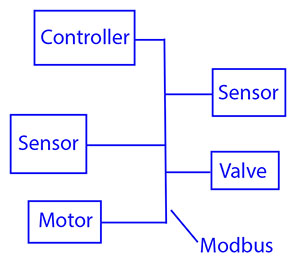
- Difference between modbus rtu and modbus tcp serial#
- Difference between modbus rtu and modbus tcp drivers#
- Difference between modbus rtu and modbus tcp full#
Difference between modbus rtu and modbus tcp drivers#
The problem is that the physical layer has a number of variations: 2-wire, 4-wire, use of common and variations in drivers and grounding methods. This worked, but it has caused a few problems in the case of RS-485. In both cases, Modbus did not add any new requirements to these physical layers. RS-232 is for point-to-point, while RS-485 is for multi-drop applications. Recommended Standards (RS) 232 and 485 were established physical layers when Modbus was first developed. Modbus ASCII and RTU both typically use either the RS-232 or RS-485 physical layer, but can also use other physical layers such as phone lines or wireless. However, if the process variable is bad or if the device has problems functioning, there is nothing in the protocol that requires the slave to report this. If the master requests data that does not make sense to the slave, then the slave can send an exception response. There is also no requirement for diagnostics related to the slave’s health. If the master never talks to them, then they are idle. They simply respond whenever a master talks to them. The slave devices do not “join” the network. There is no additional requirement for the slave or master to have a watchdog timer to ensure that communications occur within a certain time. The master will record outputs and read in inputs from each of its slaves, during every cycle, as shown in Figure 2.
Difference between modbus rtu and modbus tcp full#
The master has full control of communication on the bus, whereas a slave will only respond when spoken to. The tradeoff is that, because it uses TCP/IP protocol for all messages, it is slow compared to other Ethernet industrial protocols – but still fast enough for monitoring applications.Īs already noted, Modbus is a simple master-slave protocol. As a result, Modbus TCP/IP is also very simple to implement. There is a bit more to it than that, but this is essentially what Modbus did. One simple way of thinking about Modbus TCP/IP is to picture it as simply encapsulating a Modbus RTU packet within a TCP/IP packet. In general, RTU is more popular, particularly in new installations. ASCII encodes the message in ASCII characters, while RTU uses bytes, thus increasing the protocol’s throughput. The only difference is in the encoding of the data. Modbus RTU is really just a small variation on the Modbus ASCII protocol. The message frame and function codes, shown in Figures 1 and 1.1, are very simple. The message frame can be up to 252 bytes in length, and up to 247 addresses are possible.

All slaves are polled on demand by the master, and there is only one master.
Difference between modbus rtu and modbus tcp serial#
Modbus ASCII was the first Modbus and is a serial protocol, typically running on either the RS-232 or RS-485 physical layer. The term “Modbus” typically refers to one of three related protocols: Modbus ASCII, Modbus RTU, or Modbus TCP/IP: 1 In comparison, Profibus’ specification document is thousands of pages long. The specification document is fewer than 100 pages in length, which is a good indication of the protocol’s low level of complexity. As a result, there are now quite a few variations in the field. When it was published, a number of companies started using it, creating different interpretations and modifications of the original specification. Finally, Modicon made it an open protocol. However, it was later published royalty-free so that anyone could use it. When it was first introduced, it was a proprietary protocol that only Modicon could use. “Simple” is a key descriptor for Modbus – and also its biggest strength. It was originally designed in the mid-1970s by Modicon as a way to link intelligent devices with PLCs using a simple master/slave concept. Modbus is the “granddaddy” of industrial communication protocols.

What’s more, they can complement each other in joint applications. We’ll also discuss which one works best in which applications – although there is some overlap in what each can do. Comparing the two, we’ll see that both protocols have their own particular strengths. This article provides an overview of both protocols and discuss their key strengths and applications. I have not come to bury Modbus or Profibus, nor to praise them, but rather to add some perspective and knowledge. Different protocols work better in different applications. We live in a multi-protocol world – and this will likely not change anytime soon. What‚Äôs more, they can complement each other in joint applications. It also discusses which one works best in which applications ‚Äì although there is some overlap in what each can do. This article provides an overview of both protocols and discusses their key strengths and applications.


 0 kommentar(er)
0 kommentar(er)
